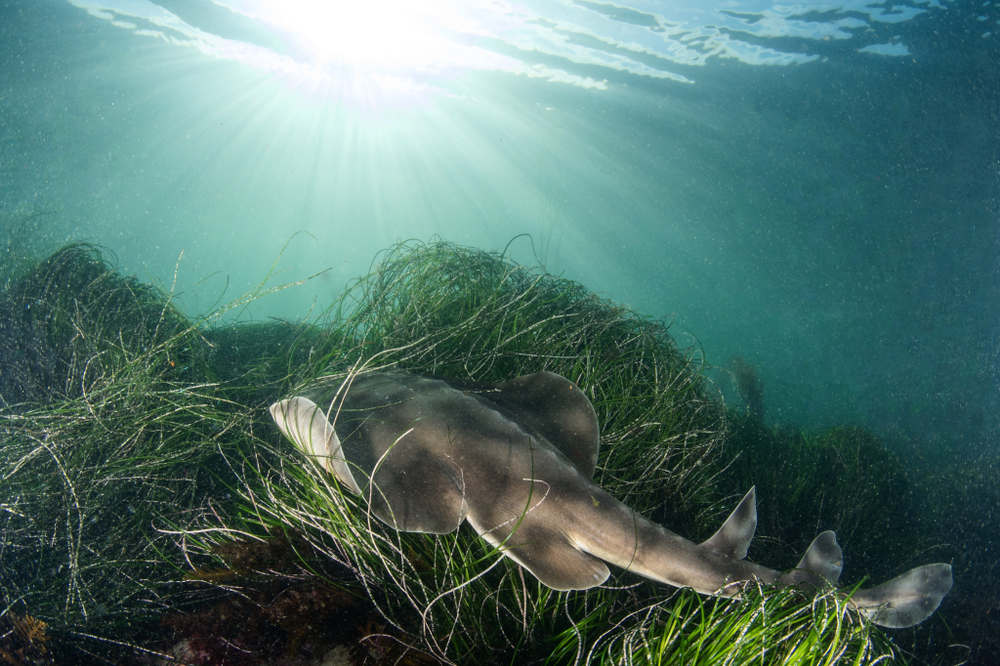Shovelnose Guitarfish at La Jolla Cove
Shark or stingray? This is what most people ask themselves when they encounter a shovelnose guitarfish on their scuba tour at La Jolla Cove. While the Rhinobatos productus, or shovel-nosed shark, is related to them, studies have shown that guitarfishes are rays and are most closely related to the diverse group of skates. These fascinating sea creatures are gorgeous sights underwater, and having some knowledge of them makes encountering them on your scuba dive more exciting! This blog will go over everything you need to know about shovelnose guitarfish at La Jolla Cove so that you’ll be knowledgeable when you catch a glimpse of them on your next scuba tour at La Jolla Cove!
Characteristics
While shovelnose guitarfish look like sharks and swim using their shark-like tail rather than flipping their pectoral fins like most rays, they are rays in the family Rhinobatidae. Its common name is derived from its guitar-shaped body and long pointed snout. Its flat body is adapted to life on the sand, and its sandy brown/olive tone helps it blend into the sandy shallow seafloor where it lives its life, usually in depths of less than 40 feet. They range from Central California to Baja California. They become mature at around the ages of seven to eight years of age. At that age, male shovelnose guitarfish grow to be between 90 to 100 cm long while females grow to be 100 cm. The ray can live up to 11 years old, and their full-grown sizes are around 120 cm for males and 137 cm for females.
Diet
A Guitarfish’s mouth is located at the bottom of its head, well-positioned for eating bottom-dwelling prey. They remain buried under inches of sand, camouflaged to the ocean floor. When unsuspecting prey such as crabs or flatfish pass by, the sand suddenly erupts and the guitar fish attacks. At night, they leave the sand to hunt for worms, clams, and other fishes by dragging the seafloor. They have the ability to crunch crabs and other shelled invertebrates with their sturdy, pebble-like teeth. Their only known predators are California sea lions and large coastal sharks. Their primary diet consists of:
- Polychaete worms
- Clams
- Amphipods
- Crabs
- Shrimp
- Bony fishes (adult shovelnose)
Reproduction
Similar to all rays and sharks, guitarfish reproduce via internal fertilization. Each embryo receives nutrients from a yolk sac. Females give live birth to well-developed young. Immediately after birth, juvenile shovelnose are set out on their own. They’re solitary creatures that don’t usually group with others.
Reaction to Divers
Shovelnose guitarfish are usually skittish and difficult to approach. While diving, it’s a good idea to view them from a distance to prevent them from swimming away.
Shovelnose Guitarfish Fun Facts
- Their genus name — Rhinobatis — is a combination of the Greek word “rhine” meaning shark and the Latin word “batis” meaning ray.
- These fish are harmless when not disturbed
- All female rays give live birth. The nursery and spawning grounds are in the bays of southern CA and Baja, where females arrive in spring and stay until early summer when they give birth. Males arrive soon after to mate and then both males and females leave the area.
- This ray is really ancient and has been around for over 100 million years!
While diving at La Jolla Cove, having some basic knowledge of the sea life at La Jolla Cove makes animal encounters so much more impactful! Shovelnose guitarfish are fascinating creatures that deserve to be appreciated! We hope this blog helped you get some knowledge on shovelnose guitarfish at La Jolla Cove! To see these beautiful rays for yourself, give San Diego Scuba Guide a call at 1-858-397-8213 or click here to book your scuba tour!


